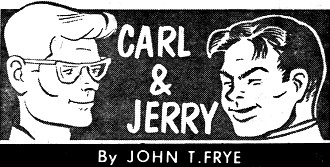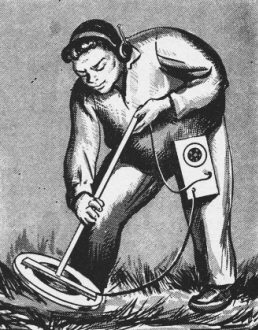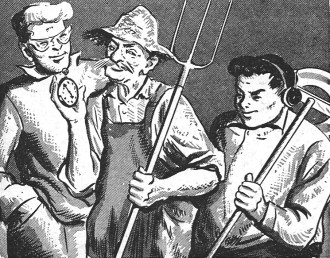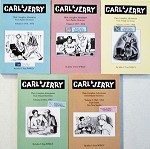Carl and Jerry: Gold Is Where You Find It
|
|||||||
Carl and Jerry: Gold Is Where You Find It
The bright first-day-of-April sunshine put new life into a fellow; so Carl vaulted nimbly over the low fence that separated his yard from that of his chum, Jerry Bishop. But he stopped short as he caught sight of his friend out on the lawn near the street. On Jerry's head was a pair of huge muff-type airplane earphones that were plugged into a small aluminum box slung from his shoulder. From this box a cord led to the strange device he held in his hands. It consisted of a long broom handle attached to the crosspiece on a large, flat wooden hoop so as to hold this hoop parallel to the ground. Jerry's round face wore a faraway look of abstract concentration as he shuffled along, waving the hoop back and forth over the sprouting grass. "Hey, Jer, what're, you doing?" Carl demanded, when he managed to catch Jerry's vacant eye. "What did you say?" Jerry asked, sliding the phones forward on his head so that he could hear. "I asked what you thought you were doing with that contraption." "You mean my worm-warmer here?" Jerry asked, with bland innocence. ''I'm just doing my bit for be-kind-to-worms-week. This is an r.f. induction coil that heats the ground beneath it and makes things comfy for the poor little worms that are still chilled from winter." "Ask an intelligent question and you get a smart answer," Carl muttered. "Are you going to tell me what that thing is, or am I going to have to squeeze that narrow hoop down over your fat and flabby body?" "All right; this is a metal locator. I built it from an article by Harvey Pollack that appeared back in the June, 1955, issue of Popular Electronics." "How does it work?" "Inside this aluminum box is an oscillator operating on about two megacycles. Shielded from it is another oscillator whose tank coil, electrostatically shielded, is wound inside this wooden hoop. Shielded wire connects the outboard tank coil to the rest of its circuit inside the box. The two oscillators are tuned to very nearly the same frequency, so that a low audio difference-frequency beat note is produced by them. This beat note is detected, amplified, and fed to the earphones. When a metallic object appears in the extensive field of the large coil in the hoop, its presence affects this field and so causes a slight frequency shift in the oscillator connected to it. This, in turn, produces an easily detected change in the beat note frequency heard in the phones and warns the operator that the probe coil is nearing some metallic object. Here," Jerry said, as he freed one of the earphones from the headband; "you walk along behind me and listen, and I'll show you what I mean." When Carl held the earphone to his ear, he heard a low-pitched musical tone. Suddenly, as Jerry moved the hoop over the grass, the note rose to a high pitch; then it went back down as Jerry kept walking. Probing the area with the coil established that there was a line perpendicular to the curb which gave the same high-pitched sound as the probe was moved along the narrow path; but if the coil were moved to either side of this path, the note in the phones returned to the normal low value. "What's down there?" Carl asked. In answer, Jerry followed the invisible object beneath the surface with the metal locator right to the curb, where a large "G'" was chiseled in the cement. Jerry's round face wore a faraway look of abstract concentration as he shuffled along, waving the wooden hoop back and forth over the sprouting grass. "It's the gas line," he explained. "The gas people marked the curb this way when the cement street was laid so that-they could find their service lines easily." "What else is the gadget good for.?" . "Locating electric cables and pipes in walls or finding any metallic objects buried in the ground, such as pipes, tanks, or - "Jerry paused dramatically:" - buried treasure!" Carl's eyes opened wide behind his horn-rimmed glasses. "You're holding out on me!" he accused. "Give!" Jerry leaned on the handle of the metal locator as he talked: "Saturday, a week ago, old Mr. Gruber and I went up Eel River to the mouth of Tick Creek fishing. They didn't bite very lively, and we did a lot of talking. For once I managed to get him off his favorite subjects of flying saucers and space travel, and he told me an old legend he had heard from his father. "A flock of years ago, the government bought all this land from an Indian tribe that lived on it. The government paid the Indians $80,000 in gold and gave them a new reservation in the Northwest. An escort of soldiers was to accompany the tribe to its new home. "While still in the assembly encampment, the Indians heard the soldiers talking and decided, rightly or wrongly, that these soldiers planned to rob them of their gold on the journey; so, secretly, during the dead of night, the elders of the tribe buried the gold on the banks of Eel River. Unfortunately, smallpox broke out among the Indians on their march to their new home, and not a single member of the party that buried the gold survived; consequently, it's still there waiting for someone to find it . "According to Mr. Gruber, when he was a boy, he and his friends used to hunt for the gold all up and down the river. Later, when he. was grown, the legend became a sort of hobby with him, and he read every scrap about it he could find. Out of this study came the conviction that the assembly encampment must have been very near the mouth of Tick Creek and that the gold is buried in that vicinity. Of course, this still leaves a lot of territory to be explored by tedious digging; but with a gadget like this, a person could go over a lot of ground in a hurry -" "Well, what are we waiting for?" Carl demanded. "I'll get a couple of shovels and a pick, and a tow sack to bring back the loot, and you get your bike. Yo ho ho, and a bottle of rum!" Tick Creek emptied into Eel River only a short distance above the town; so within the hour the boys had hidden their bicycles in the bushes along the road and were trudging across the cornfield that lay between the road and the thin line of trees. marking the river bank.
"Hey, Jer," Carl said, as he strode along with the digging tools cradled in his arms, "do you think we ought to ask permission from Mr. Sloan, who owns this farm, before we start looking for the gold?" "Naw," Jerry replied. "In the first place, he's an old crab and would say no automatically. Then, too, I'd feel kind of silly telling him we wanted to go treasure hunting on his farm. He'd think we'd both blown our corks for sure. Of course, if we find anything, we'll tell him and divide up with him." By the time this serious matter was settled, the boys had reached the point where shallow Tick Creek flowed into Eel River, thrusting a flat sandbar halfway across the larger stream. Jerry at once unlimbered his metal locator and began a systematic survey of the area, while Carl tagged along at his heels breathing down the back of his neck: The boys had been prospecting for scarcely ten minutes when Jerry suddenly stopped dead in his tracks so abruptly that Carl stumbled into him. "What is it? What do you hear?" Carl shouted anxiously. "There's something down there," Jerry said slowly, as he moved the probing hoop around , in an exploring circle. "It's right here, and it seems to be about as big around as a small washtub." As Jerry finished speaking, Carl thrust him aside and began digging feverishly at the spot where the metal locator had given the strongest indication. Even Jerry, who ordinarily had a strong aversion to any kind of physical exercise, grabbed up the other shovel and began turning over the soft earth. The boys quickly sank a shaft about three feet in diameter, and when it had reached such a depth that the edge of the hole came about to Carl's chest, his shovel suddenly gave forth with the hair-raising sound of metal scraping on metal. "Easy now," Jerry admonished, as he knelt at the, side of the hole and peered intently down to where Carl was gently scraping the dirt away with the edge of the shovel. "Aw, heck!" Carl suddenly said, with deep disappointment. "It's just a roll of old fence wire." "And what did you expect?" a gruff voice asked from behind him. The heads of both boys jerked up to see a scowling farmer, carrying a pitchfork, towering over them. "What do you young rascals think you're doing?" he demanded. "Now, climb right out of that hole and start filling it up. You think I want one of my cows stepping in that and breaking her leg and making it necessary for me to destroy her? What are you trying to do, anyway?" As the boys meekly started shoveling the earth back into the hole, they told him about the legend and tried to explain the operation of their metal locator. "A likely cock-and-bull story!" Mr. Sloan sneered. "I've never held with these scientific gadgets since I gave a fellow with a peach tree fork ten dollars to twitch a well site for me. We drove straight down a hundred and forty feet right where he said and never struck a drop of good water. You just gather up your junk, and I'll personally escort you off my property. And if you know what's good for you, you'll never set foot on it again." Jerry rigged himself up in his metal locator, and Carl gathered up the tools. All three started across the cornfield toward the road, with Mr. Sloan - his pitchfork cradled in the crook of his arm - following behind Jerry. When they were about halfway across the field, Jerry stopped so abruptly that Mr. Sloan narrowly averted thrusting the tines of the pitchfork into the boy's leg. "What are you trying to do ... make me hurt you so you can sue me?" Mr. Sloan bellowed. "Keep moving." "Wait a minute," Jerry said, as he moved the search coil about over the broken cornstalks. "I'm getting an indication of something down here." He set the probe down, dropped to his knees, and began to scrape away at the soft earth where he had obtained the strong reading. In a moment he stood up, dangling something from a dirt-encrusted chain that glinted yellowly in the sun. "Here, let me see that," Mr. Sloan said sharply. He brushed aside more of the clinging dirt and then exclaimed, "Well I'll be danged if it's not my pappy's old watch that I lost when I was checking corn last spring. I sure thought I'd never set eyes on it again, and that grieved me sorely, for I put a great store in that old turnip. The case is heavy gold, and it was given to my father by my mother on their wedding day. See, here's an inscription on the inside. I wouldn't trade it for the finest diamond-studded watch you could buy." He paused a moment and then went on: "I'm mighty obliged to you boys for finding it for me, and here's five dollars each for you. Take it; I won't have it any other way. What's more, I'm downright ashamed of acting so crabby with you before." "Aw, that's all right, Mr. Sloan," Jerry said. "We really should have asked your permission before we trespassed on your property anyway. What tickles me, though, is that we were able to prove to you that this gadget, unlike that fellow's peach tree fork, really does what it's supposed to do." "Well, you certainly convinced me," Mr. Sloan said heartily, with a broad and friendly grin; "and I'll tell you what! I have to take a load of steers to the sales barn today; but if you fellers can come back tomorrow afternoon, I'll get my shovel and go along with you, and we'll comb this old farm of mine with that gold-sniffing gadget of yours to a fare-you-well ... that is, if you don't mind letting a crabbed old cuss like me in on the fun.'" "Tickled to have you, Mr. Sloan!" the boys chorused together. "I'll be danged if it's not my pappy's old watch that I lost when I was checking corn last spring."
Posted March 28, 2022
|
|||||||


 By John T. Frye
By John T. Frye 

 Carl & Jerry, by John T. Frye
Carl & Jerry, by John T. Frye